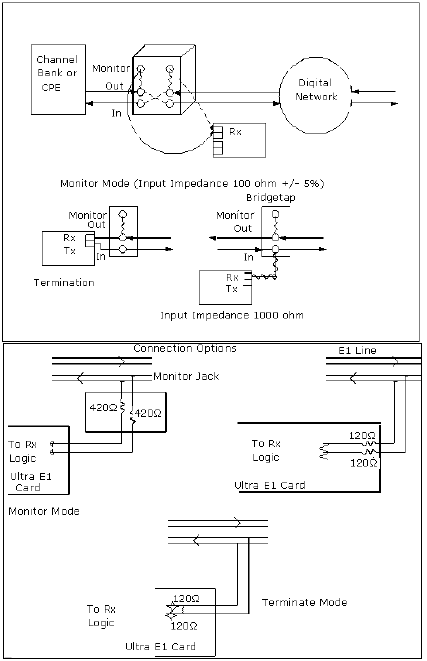T1 E1 Connection Options

Overview
The T1/E1 input signal may be terminated using impedance, monitored, or bridged depending on user requirements.
Description
Terminate
The incoming signal is electrically terminated in 100 ohms for T1 signals, 120 ohms for E1 signals. This form of connection is normally used when connecting directly to a T1/E1 signal rather than monitoring a signal on an existing T1/E1 connection.
Bridge
The incoming signal is in series with a pair of 420-ohm resistors prior to termination with either 100 ohm (T1) or 120-ohm (E1) resistance. The pair wise 420-ohm resistance appears as a high impedance connection to the signal, and thereby renders the "tap" non-intrusive. This form of connection is normally used to non-intrusively monitor transmissions on an existing T1/E1 connection. A "T" type of tap is required to simultaneously pass the signal to its intended destination and to provide a connection to the T1/E1 board.
Monitor
The incoming signal is assumed to originate from a monitor jack (which provides a tap and a pair wise series resistance of 420 ohms). On the board the signal is terminated with either 100 ohm (T1) or 120ohm (E1) resistance. This form of connection is normally used to non-intrusively monitor transmissions on an existing T1/E1 connection. A monitor signal is usually at a level of-20dBsx that is 20 dB down from the nominal signal level measured at a DSX panel.
The interfaces to the T1/E1 Cards or Dual Laptop Units are balanced 120 ohm (E1) or balanced 100 ohm (T1) electrically. Systems employing 120-ohm interfaces can connect directly to the Cards or Dual Laptop Units. When connecting to systems employing 75-ohm interfaces, as is sometimes encountered in E1 systems, a 120-to-75 ohm transformer may be used. Contact GL Communications for these adapters. Connecting an unbalanced 75-ohm signal to a balanced 120-ohm interface (using a BNC to Bantam cable) will generally work for short distances.
